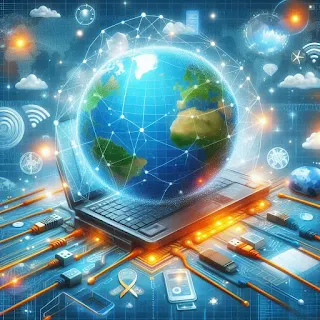2wIn a time when digital revolution is changing every part of our life, technology is still advancing at an unstoppable pace. With 5G networks expected to spread out globally and offer extremely low latency and lightning-fast speeds, scientists and business executives are already looking toward the future. Greetings from the future beyond 5G, where the advancement of connection holds the potential toste24224 completely alter our percepttion of technology and the structure of our2iww4 globa24jrlly networked environment.
6G's Arrival: A Quantum Advance in Connectivity-
Though 5G is still in its early stages, 6G's foundation is already being set. Anticipated to launch in the vicinity of4 2030, 6G promises to be a zrww3r4wrevolutionary advancement in wireless technology, not merely a minor enhancement. peak data rates of one terabit per second are the goal 2a%r4eof 6G, which promises theoretical speeds up to 100 times faster than 5G. To put this into perspective, one second would be enough to download 142 hours of high-quality video.However, speed alone is only the beginning. The near-zero latency and unparalleled dependability that 6G offers will be the true revolution. This creates a universe of opportunities that were previously exclusive to science fiction:
- Holographic Communication: Forget video calls. Imagine holographic projections that make it feel like you're in the same room as someone on the other side of the planet.
- Internet of Senses: Beyond sight and sound, 6G could enable the transmission of touch, smell, and even taste over distances, creating truly immersive experiences.
- Autonomous Systems: From self-driving cars to robot-assisted surgeries, 6G will enable real-time control and coordination of complex autonomous systems.
- Digital Twins: Highly accurate digital replicas of physical objects and environments, updated in real-time, could revolutionize fields from urban planning to healthcare.
Taking a Terahertz Wave Ride-
The terahertz frequency range is a new frontier that 6G will need to explore in order to meet these lofty objectives. While 6G networks are expected to use frequencies between 100 GHz and 10 THz, current cellular networks function below this frequency range. Large bandwidth is available in this uncharted spectrum, allowing massive volumes of data to be sent.Nevertheless, there are unique difficulties associated with using terahertz radiation. These high-frequency signals struggle to get through obstructions and have a short range. Innovative solutions, such the following, will be needed to overcome these constraints:
- Advanced Beamforming: Highly directional signal transmission to extend range and improve signal quality.
- Intelligent Reflective Surfaces: Smart materials that can redirect signals around obstacles.
- Dense Network of Small Cells: A much larger number of smaller, lower-power base stations to ensure coverage
AI: The Brain Behind the Network-
If 6G is the body of future networks, Artificial Intelligence will be its brain. AI won't just be a feature of these networks—it will be fundamental to their operation. Here's how AI will transform connectivity:
- Self-Optimizing Networks: AI algorithms will continuously analyse network performance, predicting and preventing issues before they occur.
- Dynamic Resource Allocation: Network resources will be intelligently allocated in real-time based on demand, ensuring optimal performance.
- Personalized User Experiences: AI will learn user behaviours and preferences, tailoring network performance to individual needs.
- Autonomous Network Management: Complex network operations will be handled by AI, reducing the need for human intervention and improving efficiency.
- Predictive Maintenance: AI will forecast equipment failures and schedule maintenance, minimizing downtime and reducing costs.
The Internet of Everything: A Revolutionary Approach to Networking-
We are not only growing the Internet of Things (IoT) as we get past 5G; rather, we are moving in the direction of the Internet of Everything (IoE). This new paradigm envisions a hyper-connected world in which trillions of devices—from enormous industrial machines to miniscule sensors—are seamlessly incorporated into a single, intelligent network.The implications of IoE are profound:
- Smart Cities: Urban environments where every aspect, from traffic flow to energy usage, is optimized in real-time.
- Precision Agriculture: Farms where every plant is monitored and cared for individually, maximizing yield and minimizing resource use.
- Ambient Intelligence: Environments that adapt to human presence and needs automatically, enhancing comfort and efficiency.
- Swarm Robotics: Large groups of small robots working together to accomplish complex tasks, from disaster response to space exploration.
Transforming Our World: The Far-Reaching Impact of Advanced Connectivity
The ripple effects of these advancements will be felt across every sector of society:
- Healthcare Revolution:
- Telemedicine will evolve beyond video consultations to include remote surgeries performed with robotic precision.
- Wearable and implantable devices will continuously monitor health metrics, predicting and preventing illnesses before symptoms appear.
- AI-powered diagnostics will analyse vast amounts of medical data, leading to more accurate diagnoses and personalized treatment plans.
- Reimagining Transportation:
- Autonomous vehicles will communicate in real-time, not just with each other but with smart infrastructure, dramatically improving safety and efficiency.
- Flying taxis and delivery drones will become viable options for urban transportation, requiring robust and ubiquitous connectivity.
- Hyperloop systems and other advanced transportation methods will rely on ultra-fast, low-latency networks for safe operation.
- Education Without Borders:
- Virtual and augmented reality classrooms will provide immersive, hands-on learning experiences regardless of physical location.
- AI tutors will adapt in real-time to each student's learning style and pace, providing truly personalized education.
- Collaborative learning environments will connect students and experts from around the world, fostering global knowledge exchange.
- Environmental Stewardship:
- Vast networks of sensors will monitor environmental conditions in real-time, from tracking deforestation to measuring air quality in cities.
- Smart grids will optimize energy distribution, integrating renewable sources more efficiently and reducing waste.
- Precision conservation techniques will use data from connected devices to protect endangered species and ecosystems.
- Transforming Work and Industry:
- Remote work will evolve beyond video calls to include fully immersive virtual offices and collaborative spaces.
- Digital twins of factories and supply chains will enable real-time optimization and predictive maintenance.
- New industries will emerge around the management and analysis of the vast amounts of data generated by connected devices.
Challenges on the Horizon: Navigating the Path to the Future
While the potential of advanced connectivity is immense, significant challenges lie ahead:
- Infrastructure Investment: The rollout of these advanced networks will require massive investments in new infrastructure. From dense arrays of small cells to new types of antennas and upgrades to backend systems, the costs will be substantial. Ensuring a return on this investment will be crucial for telecom companies and may require new business models and partnerships.
- Energy Efficiency: As data usage and the number of connected devices skyrocket, so does energy consumption. Developing energy-efficient hardware and network management systems will be crucial to make future networks sustainable. This includes research into new materials, more efficient signal processing algorithms, and smart power management systems.
- Privacy and Security: With more devices collecting more data than ever before, protecting user privacy and securing networks against cyber threats becomes increasingly complex. Developing robust encryption methods, implementing strict data governance policies, and educating users about digital privacy will be essential.
- Equitable Access: As advanced connectivity becomes more crucial for economic and social participation, ensuring equitable access to these technologies globally becomes a pressing concern. Bridging the digital divide between urban and rural areas, as well as between developed and developing nations, will be a significant challenge.
- Regulatory Frameworks: The rapid pace of technological advancement often outstrips the ability of regulatory bodies to keep up. Developing flexible yet robust regulatory frameworks that protect consumers while fostering innovation will be crucial.
- Health and Environmental Concerns: As we push into higher frequency bands and increase the density of wireless transmitters, addressing concerns about potential health and environmental impacts will be important for public acceptance.
Final Thoughts: Welcome to the Connected Future
It's obvious that there will be profound changes as we approach this new era of connection. The road beyond 5G is about reinventing the entire nature of our interaction with technology and with each other, not just about faster internet or more connected gadgets.The development of connectedness has the promise of dismantling time and space boundaries, opening up new horizons for human potential, and providing answers to some of the most urgent global issues we face. The opportunities are both thrilling and limitless, ranging from transforming healthcare and education to halting climate change and promoting international cooperation.
The era of connectedness is beckoning, presenting us with an unparalleled array of opportunities. Not only will the next phase of digital innovation be determined by our response to this appeal, but also the course of human advancement in general, by the way we develop and apply new technologies. One thing is clear as we enter this brave new world: the most fascinating chapters in the history of human connectedness are still to come.








.png)



0 Comments